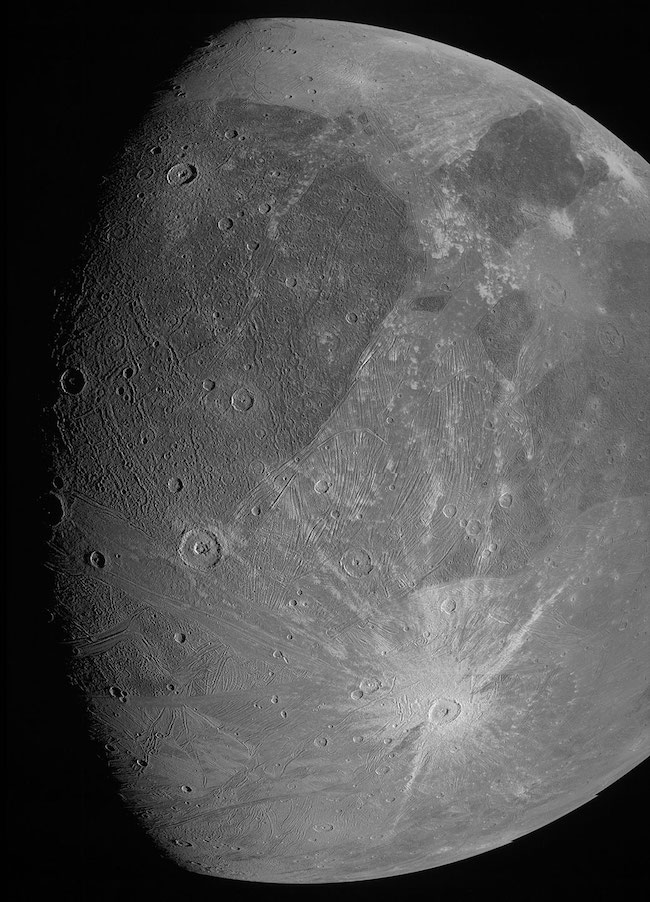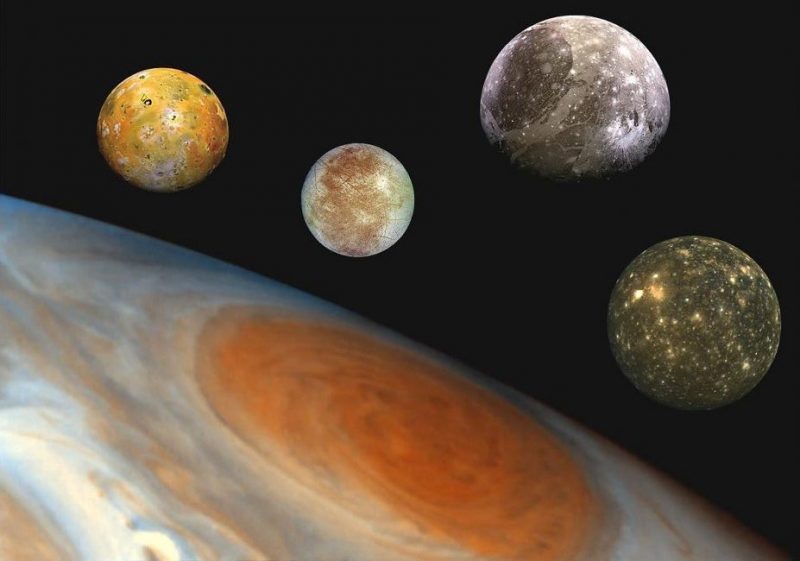In 1610 Galileo pointed his newly invented telescope at Jupiter. He discovered four new worlds orbiting Jupiter. They are now known as Jupiter’s Galilean moons. In order of their distance from Jupiter, these moons are Io, Europa, Ganymede, and Callisto.
These moons are comparable in size to Earth’s moon. They are mixtures of rock and ice. The more distant moons from Jupiter have a lower density. This observation shows that distant moons contain a more significant percentage of ice and a lower portion of the rock.
Contents
What are the properties of Jupiter’s four largest Moons: Io, Europa, Ganymede, and Callisto?
Geological Activity
The two more distant moons, Ganymede and Callisto, are covered with craters formed by meteorite impacts. The closer moons, Io and Europa, are not.
This fact tells us that Io and Europa are more geologically active. Geological activity destroys impact craters. As a general rule in the solar system, worlds with more geological activity have fewer impact craters on their surfaces.
For a planet or moon to have geological activity, the interior must be hot. Interior heat energy provides the energy needed to drive geological activity such as volcanoes, earthquakes, and other tectonic activity.
Small objects cool more quickly than large objects. Hence moons and more minor planets are usually not geologically active. Io and Europa are geologically active, and Io is among the most geologically active worlds in the solar system. Why? The key is tidal heating from Jupiter. The same difference in gravitational force that causes tides on Earth causes tidal bulges on Jupiter’s closer moons. Friction from the moving tidal bulges heats the interior. The closer the moon is to Jupiter, the greater the tidal heating effect.

Io
Io is the closest of the Galilean moons to Jupiter. Tidal forces make it the most geologically active. Io is the only world in the solar system other than Earth that has known active volcanoes. These volcanoes spew ionized gas into a donut-shaped ring around Jupiter along Io’s orbit.

Equipment Details:
Equipment Used: 8″ Skywatcher Flextube Dobsonian, EQ Platform, ZWO ASI178MC, 2.5X Powermate SvBony UV/IR Filter.
Europa
Europa’s surface looks like a smooth icy surface covered with tiny cracks. Europa is a mixture of rock and ice with a small metallic core. The denser materials sunk to the interior. The frozen icy surface has many cracks because tidal heating from Jupiter warmed and melted the interior. As the interior ice melted, it shrunk (Remember that water expands when it freezes.) and caused the surface ice to crack. The oceans of water underneath Europa’s frozen surface lead many scientists to speculate about the possibility of life on Europa.
Ganymede
Ganymede is also a mixture of about half rock and half ice with a small metallic core. It is far enough from Jupiter that there is insufficient tidal heating to melt the ice. Much of the terrain on Ganymede is covered with impact craters indicating that these areas are geologically inactive. Ganymede does however have areas of grooved terrain, which indicate some geologic activity in the distant past.


Callisto
Callisto is about half ice and half rock. Callisto’s surface is saturated with impact craters, telling us that Callisto is geologically inactive. The most prominent impact feature on Callisto is Valhalla. It is a crater about 600 kilometers (370 miles) in diameter surrounded by a couple of dozen concentric rings similar to the ripples that form when a small rock impacts a still pond. They apparently melted from a meteorite impact and refroze too quickly after the impact for the waves to subside.
The Best Way to see Jupiter’s Moons
From Earth, the moons appear as tiny star-like specks of light when viewed via a small telescope or good binoculars.
But they’re not stars, though, because they’re extended out in a line that crisscrosses Jupiter. Depending on the type of optic equipment you use, you may only see one moon or all four. If you see less than four moons, one of them may be behind – or in front of — Jupiter. When a moon passes in front of Jupiter, its shadow can be seen on the planet’s cloud tops. Transit is a name given to this shadow.
Jupiter’s four largest moons lose their star-like appearance when magnified at 150x or more, revealing disks ranging in size from 1.0′′ to 1.7′′. (current opposition). Europa is the smallest, whereas Ganymede is the largest.


